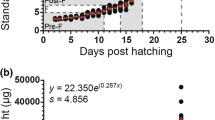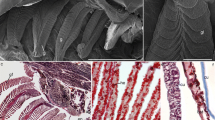Abstract
Ray-finned fishes of the superorder Ostariophysi are primarily freshwater (FW), and normally stenohaline. Differently, fishes of the superorder Acanthopterygii are essentially marine, and frequently euryhaline, with some secondary FW. Na+/K+-ATPase-immunoreactive ionocytes were localized in the branchial epithelia of 4 species of Ostariophysi and 3 of Acanthopterygii. The Ostariophysi grass carp (Ctenopharyngodon idella, Cypriniformes), twospot Astyanax (Astyanax bimaculatus) and piracanjuba (Brycon orbignyanus), Characiformes, and the jundiá (Rhamdia quelen, Siluriformes), all from FW, displayed ionocytes in the filament plus secondary lamellae (F + SL). In their turn, all the three species of Acanthopterygii showed immunoreactive ionocytes in the filaments only (F). They were the Nile tilapia (Oreochromis niloticus, Cichliformes) in FW, the dog snapper (Lutjanus jocu, Perciformes) in seawater (SW), and the green puffer (Sphoeroides greeleyi, Tetraodontiformes) in SW. Ionocytes normally extend their distribution to the secondary lamellae (F + SL) in Ostariophysi. In Acanthopterygii, we find more plasticity: ionocytes are more frequently restricted to the filament in SW, but also spread to SL in FW. It may be that the occurrence of ionocytes in SL is the ancestral condition, but some euryhaline acanthopterygians rely on the space of the SL for placement of additional ionocytes when in FW absorbing salt. Our study contributed to the identification of the pattern of ionocyte distribution in gills of Ostariophysi in respect to that of Acanthopterygii.
Graphical abstract




Similar content being viewed by others
Data availability
Data can be made available on request to Dr. Carolina A. Freire.
References
Armesto P, Campinho MA, Rodríguez-Rúa A, Cousin X, Power DM, Manchado M, Infante C (2014) Molecular characterization and transcriptional regulation of the Na+/K+ATPase α subunit isoforms during development and salinity challenge in a teleost fish, the Senegalese sole (Solea senegalensis). Comp Biochem Physiol B 175:23–38. https://doi.org/10.1016/j.cbpb.2014.06.004
Evans DH (2009) Osmotic and ionic regulation: cells and animals. CRC Press, Boca Raton
Evans DH (2011) Freshwater fish gill ion transport: August Krogh to morpholinos and microprobes. Acta Physiol 202:349–359. https://doi.org/10.1111/j.1748-1716.2010.02186.x
Evans DH, Claiborne JB (2009) Osmotic and ionic regulation in fishes. In: Evans DH (ed) Osmotic and ionic regulation: cells and animals, 1st edn. CRC Press, Boca Raton, pp 295–366
Evans DH, Piermarini PM, Choe KP (2005) The multifunctional fish gill: dominant site of gas exchange, osmoregulation, acid-base regulation, and excretion of nitrogenous waste. Physiol Rev 85:97–177. https://doi.org/10.1152/physrev.00050.2003
Freire CA, Prodocimo V (2007) Special challenges to teleost fish osmoregulation in environmentally extreme or unstable habitats. In: Baldisserotto B, Mancera JM, Kapoor BG (eds) Fish osmoregulation, 1st edn. CRC Press, Boca Raton, pp 249–276
Freire CA, Amado EM, Souza LR, Veiga MPT, Vitule JRS, Souza MM, Prodocimo V (2008) Muscle water control in crustaceans and fishes as a function of habitat, osmoregulatory capacity, and degree of euryhalinity. Comp Biochem Physiol A 149:435–446. https://doi.org/10.1016/j.cbpa.2008.02.003
Fridman S (2020) Ontogeny of the osmoregulatory capacity of teleosts and the role of ionocytes. Front Mar Sci 7:709. https://doi.org/10.3389/fmars.2020.00709
Gutierre SMM, Vitule JRS, Freire CA, Prodocimo V (2014) Physiological tools to predict invasiveness and spread via estuarine bridges: tolerance of Brazilian native and worldwide introduced freshwater fishes to increased salinity. Mar Freshw Res 65:425–436. https://doi.org/10.1071/MF13161
Hiroi J, McCormick SD (2012) New insights into gill ionocyte and ion transporter function in euryhaline and diadromous fish. Respir Physiol Neurobiol 184:257–268. https://doi.org/10.1016/j.resp.2012.07.019
Hsu HH, Lin LY, Tseng YC, Horng JL, Hwang PP (2014) A new model for fish ion regulation: identification of ionocytes in freshwater- and seawater-acclimated medaka (Oryzias latipes). Cell Tissue Res 357:225–243. https://doi.org/10.1007/s00441-014-1883-z
Hu YC, Chu KF, Yang WK, Lee TH (2017) Na+, K+-ATPase β1 subunit associates with α1 subunit modulating a “higher-NKA-in-hyposmotic media” response in gills of euryhaline milkfish, Chanos chanos. J Comp Physiol B 187:995–1007. https://doi.org/10.1007/s00360-017-1066-9
Huang CY, Chao PL, Lin HC (2010) Na+/K+-ATPase and vacuolar-type H+-ATPase in the gills of the aquatic air-breathing fish Trichogaster microlepis in response to salinity variation. Comp Biochem Physiol A 155:309–318. https://doi.org/10.1016/j.cbpa.2009.11.010
Hwang PP, Lee TH, Lin LY (2011) Ion regulation in fish gills: recent progress in the cellular and molecular mechanisms. Am J Phys 301:R28–R47. https://doi.org/10.1152/ajpregu.00047.2011
Kang CK, Tsai SC, Lee TH, Hwang PP (2008) Differential expression of branchial Na+/K+-ATPase of two medaka species, Oryzias latipes and Oryzias dancena, with different salinity tolerances acclimated to fresh water, brackish water and seawater. Comp Biochem Physiol A 151:566–575. https://doi.org/10.1016/j.cbpa.2008.07.020
Kang CK, Lin CS, Hu YC, Tsai SC, Lee TS (2017) The expression of VILL protein in hypoosmotic-dependent in the lamellar gill ionocytes of Otocephala teleost fish, Chanos chanos. Comp Biochem Physiol A 203:59–68. https://doi.org/10.1016/j.cbpa.2016.08.016
Lee TH, Feng SH, Lin CH, Hwang YH, Huang CL, Hwang PP (2003) Ambient salinity modulates the expression of sodium pumps in branchial mitochondria-rich cells of Mozambique tilapia, Oreochromis mossambicus. Zool Sci 20:29–36. https://doi.org/10.2108/zsj.20.29
Li Z, Lui EY, Wilson JM, Ip YK, Lin Q, Lam TJ, Lam SH (2014) Expression of key ion transporters in the gill and esophageal-gastrointestinal tract of euryhaline Mozambique tilapia Oreochromis mossambicus acclimated to fresh water, seawater and hypersaline water. PLoS One 9. https://doi.org/10.1371/journal.pone.0087591
Lin HC, Sung WT (2003) The distribution of mitochondria-rich cells in the gills of air-breathing fishes. Physiol Biochem Zool 76:215–228. https://doi.org/10.1086/374278
Lin YM, Chen CN, Lee TH (2003) The expression of gill Na+, K+ − ATPase in milkfish, Chanos chanos, acclimated to seawater, brackish water and fresh water. Comp Biochem Physiol 135:489–497. https://doi.org/10.1016/s1095-6433(03)00136-3
Madsen SS, Jensen LN, Tipsmark CK, Kiilerich P, Borski RJ (2007) Differential regulation of cystic fibrosis transmembrane conductance regulator and Na+,K+-ATPase in gills of striped bass, Morone saxatilis: effect of salinity and hormones. J Endocrinol 192:249–260. https://doi.org/10.1677/joe-06-0016
Marshall WS, Grosell M (2006) Ion transport, osmoregulation, and acid-base balance. In: Evans DH, Claiborne JB (eds) The physiology of fishes, 3rd edn. Taylor and Francis Group, Boca Raton, pp 177–230
McCormick SD, Regish AM, Christensen AK (2009) Distinct freshwater and seawater isoforms of Na+/K+-ATPase in gill chloride cells of Atlantic salmon. J Exp Biol 212:3994–4001. https://doi.org/10.1242/jeb.037275
Moron SE, Fernandes MN, Yokishoka ETO (2003) Chloride cells responses to ion challenge in two tropical freshwater fish, the erythrinids Hoplias malabaricus and Hoplerythrinus unitaeniatus. J Exp Zool A 298:93–104. https://doi.org/10.1002/jez.a.10259
Nelson JS, Grande TC, Wilson MVH (2016) Fishes of the world. Wiley, Hoboken
Ouattara N’G, Bodinier C, Nègre-Sadargues G, D’Cotta H, Messad S, Charmantier G, Panfilli J, Baroiller JF (2009) Changes in gill ionocyte morphology and function following transfer from fresh to hypersaline waters in the tilapia Sarotherodon melanotheron. Aquaculture 290:155–164. https://doi.org/10.1016/j.aquaculture.2009.01.025
Perry SF (1997) The chloride cell: structure and function in the gills of freshwater fishes. Annu Rev Physiol 59:325–347. https://doi.org/10.1146/annurev.physiol.59.1.325
Prodocimo V, Freire CA (2006) The Na+,K+,2Cl− cotransporter of estuarine pufferfishes (Sphoeroides testudineus and S. greeleyi) in hypo- and hyper-regulation of plasma osmolality. Comp Biochem Physiol C 142:347–355. https://doi.org/10.1016/j.cbpc.2005.11.013
Reis-Santos P, McCormick SD, Wilson JM (2008) Ionoregulatory changes during metamorphosis and salinity exposure of juvenile sea lamprey (Petromyzon marinus L.). J Exp Biol 211:978–988. https://doi.org/10.1242/jeb.014423
Saitoh K, Miya M, Inoue JG, Ishiguro NB, Nishida M (2003) Mitochondrial genomics of ostariophysan fishes: perspectives on phylogeny and biogeography. J Mol Evol 56:464–472. https://doi.org/10.1007/s00239-002-2417-y
Schultz ET, McCormick SD (2013) Euryhalinity in an evolutionary context. EEB Articles. Paper 29. http://digitalcommons.uconn.edu/eeb_articles/29
Shaugnessy CA, Breves JP (2020) Molecular mechanisms of Cl− transport in fishes: new insights and their evolutionary context. J Exp Zool. https://doi.org/10.1002/jez.2428
Souza-Bastos SR, Freire CA (2009) The handling of salt by the neotropical cultured freshwater catfish Rhamdia quelen. Aquaculture 289:167–174. https://doi.org/10.1016/j.aquaculture.2009.01.007
Tang CH, Hwang LY, Shen ID, Chiu YH, Lee TH (2011) Immunolocalization of chloride transporters to gill epithelia of euryhaline teleosts with opposite salinity-induced Na+/K+-ATPase responses. Fish Physiol Biochem 37:709–724. https://doi.org/10.1007/s10695-011-9471-6
Wilson J, Laurent P, Tufts BL, Benos DJ, Donowitz M, Vogl AW, Randall DJ (2000) NaCl uptake by the branchial epithelium in freshwater teleost fish: an immunological approach to ion-transport protein localization. J Exp Biol 203:2279–2296
Wilson JM, Leitão A, Gonçalves AF, Ferreira C, Reis-Santos P, Fonseca A, Silva JM, Antunes JC, Pereira-Wilson C, Coimbra J (2007) Modulation of branchial ion transport protein expression by salinity in glass eels (Anguilla anguilla L.). Mar Biol 151:1633–1645. https://doi.org/10.1007/s00227-006-0579-7
Wood CM, Grosell M (2015) Electrical aspects of the osmorespiratory compromise: TEP responses to hypoxia in the euryhaline killifish (Fundulus heteroclitus) in freshwater and seawater. J Exp Biol 218:2152–2155. https://doi.org/10.1242/jeb.122176
Acknowledgements
This work is part of the Doctoral Dissertation of FJMC, conducted at the Graduate Program in Physiology of the Federal University of Paraná (UFPR) (http://hdl.handle.net/1884/28411). The authors also wish to thank the help by Professor Edvaldo S. Trindade, as well as from the technicians of the Confocal Microscopy Center of UFPR, Israel H. Bini, Lisandra S. Ferreira-Maba, and Alessandra C. S. dos Santos. The authors also thank the Hybridoma Bank of the Department of Biological Sciences of the University of Iowa, for the production of the antibody to the NKA. The authors also thank both reviewers for very useful suggestions to improve the manuscript.
Funding
This study received financing from CNPq (Research Grants awarded to CAF, #306630/2011–7, and #479350/2010–8), and CAPES-PRODOC (AUXPE PRODOC 2620/2010), Brazilian Government Sponsors.
Author information
Authors and Affiliations
Contributions
CAF had the original idea and FJMC and VP prepared the samples and produced the images and discussed the data; FJMC wrote a first version of the manuscript. CAF prepared the table with FJMC and VP and organized the analysis and discussion of the results and edited the text of the manuscript to its final form.
Corresponding author
Ethics declarations
Ethics approval
Experimental handling of the fish was approved by the Ethics Committee on Animal Research of the Biological Sciences Sector of the Federal University of Paraná (CEUA Certificate #550, issued on June 7, 2011).
Consent to participate and for publication
All authors consent to participate in this manuscript, as well as agree on its submission.
Conflict of interest
The authors declare no competing interests.
Additional information
Publisher’s note
Springer Nature remains neutral with regard to jurisdictional claims in published maps and institutional affiliations.
Highlights
• The distribution of Na+/K+-ATPase (NKA) immunoreactive ionocytes has been compared between two superorders;
• NKA was immunodetected in the filament and secondary lamellae in the four Ostariophysii;
• NKA ionocytes were restricted to the filaments in the three Acanthopterygii, in species from both freshwater and seawater;
• Lamellar ionocytes are more frequent in the gills of primary freshwater fishes, or euryhaline fishes acclimated to FW.
Supplementary Information
Table S1
(DOC 108 kb)
Rights and permissions
About this article
Cite this article
Ceron, F.J.M., Prodocimo, V. & Freire, C.A. Distribution of Na+/K+-ATPase-immunoreactive ionocytes varies between two superorders of ray-finned fish: Ostariophysi and Acanthopterygii. Fish Physiol Biochem 47, 1063–1071 (2021). https://doi.org/10.1007/s10695-021-00963-4
Received:
Accepted:
Published:
Issue Date:
DOI: https://doi.org/10.1007/s10695-021-00963-4




